A Nucleic Acid-Based Orthopoxvirus Vaccine Targeting the Vaccinia Virus L1, A27, B5, and A33 Proteins Protects Rabbits against Lethal Rabbitpox Virus Aerosol Challenge
- PMID: 34851148
- PMCID: PMC8826804
- DOI: 10.1128/JVI.01504-21
A Nucleic Acid-Based Orthopoxvirus Vaccine Targeting the Vaccinia Virus L1, A27, B5, and A33 Proteins Protects Rabbits against Lethal Rabbitpox Virus Aerosol Challenge
Abstract
In the age of COVID, nucleic acid vaccines have garnered much attention, at least in part, because of the simplicity of construction, production, and flexibility to adjust and adapt to an evolving outbreak. Orthopoxviruses remain a threat on multiple fronts, especially as emerging zoonoses. In response, we developed a DNA vaccine, termed 4pox, that protected nonhuman primates against monkeypox virus (MPXV)-induced severe disease. Here, we examined the protective efficacy of the 4pox DNA vaccine delivered by intramuscular (i.m.) electroporation (EP) in rabbits challenged with aerosolized rabbitpox virus (RPXV), a model that recapitulates the respiratory route of exposure and low dose associated with natural smallpox exposure in humans. We found that 4pox-vaccinated rabbits developed immunogen-specific antibodies, including neutralizing antibodies, and did not develop any clinical disease, indicating protection against aerosolized RPXV. In contrast, unvaccinated animals developed significant signs of disease, including lesions, and were euthanized. These findings demonstrate that an unformulated, nonadjuvanted DNA vaccine delivered i.m. can protect against an aerosol exposure. IMPORTANCE The eradication of smallpox and subsequent cessation of vaccination have left a majority of the population susceptible to variola virus or other emerging poxviruses. This is exemplified by human monkeypox, as evidenced by the increase in reported endemic and imported cases over the past decades. Therefore, a malleable vaccine technology that can be mass produced and does not require complex conditions for distribution and storage is sought. Herein, we show that a DNA vaccine, in the absence of a specialized formulation or adjuvant, can protect against a lethal aerosol insult of rabbitpox virus.
Keywords: DNA vaccines; aerosols; neutralizing antibodies; nucleic acid technology; poxvirus; rabbitpox; smallpox.
Conflict of interest statement
The authors declare a conflict of interest. Authors M.R. and J.B. are current or past employees of for-profit organizations, and these authors own stock or hold stock options. J.W.H. has a patent for DNA vaccines against poxviruses. E.M.M., J.W.G., C.D.H., M.D.J., and A.N. have no conflict of interest to declare.
Figures

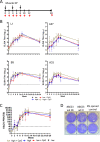
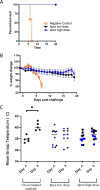
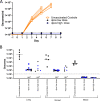
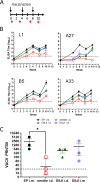
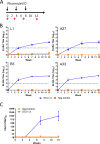
Similar articles
-
Different immunogens and prime-boost vaccination strategies affect the efficacy of recombinant candidate vaccines against pathogenic orthopoxviruses.Virol J. 2024 Nov 7;21(1):282. doi: 10.1186/s12985-024-02534-4. Virol J. 2024. PMID: 39511612 Free PMC article.
-
Polyclonal antibody cocktails generated using DNA vaccine technology protect in murine models of orthopoxvirus disease.Virol J. 2011 Sep 20;8:441. doi: 10.1186/1743-422X-8-441. Virol J. 2011. PMID: 21933385 Free PMC article.
-
Evaluating the orthopoxvirus type I interferon-binding molecule as a vaccine target in the vaccinia virus intranasal murine challenge model.Clin Vaccine Immunol. 2010 Nov;17(11):1656-65. doi: 10.1128/CVI.00235-10. Epub 2010 Sep 15. Clin Vaccine Immunol. 2010. PMID: 20844086 Free PMC article.
-
Rabbitpox: a model of airborne transmission of smallpox.J Gen Virol. 2011 Jan;92(Pt 1):31-5. doi: 10.1099/vir.0.026237-0. Epub 2010 Oct 21. J Gen Virol. 2011. PMID: 20965981 Review.
-
Animal models of orthopoxvirus infection.Vet Pathol. 2010 Sep;47(5):852-70. doi: 10.1177/0300985810378649. Epub 2010 Aug 3. Vet Pathol. 2010. PMID: 20682806 Review.
Cited by
-
A Subunit Vaccine Candidate Composed of Mpox Virus A29L, M1R, A35R, and B6R Elicits Robust Immune Response in Mice.Vaccines (Basel). 2023 Aug 25;11(9):1420. doi: 10.3390/vaccines11091420. Vaccines (Basel). 2023. PMID: 37766097 Free PMC article.
-
Development of a specific MPXV antigen detection immunodiagnostic assay.Front Microbiol. 2023 Sep 7;14:1243523. doi: 10.3389/fmicb.2023.1243523. eCollection 2023. Front Microbiol. 2023. PMID: 37744911 Free PMC article.
-
Rational development of multicomponent mRNA vaccine candidates against mpox.Emerg Microbes Infect. 2023 Dec;12(1):2192815. doi: 10.1080/22221751.2023.2192815. Emerg Microbes Infect. 2023. PMID: 36947428 Free PMC article.
-
In Vitro Affinity Maturation of Nanobodies against Mpox Virus A29 Protein Based on Computer-Aided Design.Molecules. 2023 Sep 28;28(19):6838. doi: 10.3390/molecules28196838. Molecules. 2023. PMID: 37836685 Free PMC article.
-
Immune responses following DNA vaccination by needle-free injection against Burkholderia pseudomallei hemolysin co-regulated protein 1.Front Immunol. 2025 Jun 25;16:1612540. doi: 10.3389/fimmu.2025.1612540. eCollection 2025. Front Immunol. 2025. PMID: 40636117 Free PMC article.
References
Publication types
MeSH terms
Substances
Grants and funding
LinkOut - more resources
Full Text Sources
Other Literature Sources
Miscellaneous

